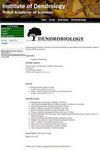土耳其北部小栎和粗壮栎自然种群的气孔密度
IF 1.8
4区 农林科学
Q2 FORESTRY
引用次数: 5
摘要
研究了两个小栎种群气孔密度的变化。和来自土耳其西北部的两个种群。在自然条件下从树木上采集的完全膨胀和干燥的叶片样本中测定了气孔密度。petraea和robur的气孔密度分别为186至459/mm2(平均值:333个气孔/mm2)和397至826/mm2(均值:517/mm2)。在土耳其的这两个橡树物种之间以及物种内的种群之间,气孔密度存在显著差异。在每个物种内和整个物种之间,气孔密度和叶长之间都存在强烈而显著的负相关。虽然在中欧,金龟子比粗壮金龟子生长在更干燥的环境中,但在本研究中,粗壮金龟草种群生长在更干旱的环境中。金龟子的叶片比金龟子更小,气孔密度更高。气孔密度与除叶窦宽度外的其它叶片性状均呈负相关。此外,与在8个微卫星位点计算的平均遗传分化(FST=0.030)相比,气孔密度的种间PST值(0.48)相对较高,表明种群的不同局部适应。为了将候选基因的遗传变异与表型和环境变异联系起来,需要进一步的研究,包括额外的群体。本文章由计算机程序翻译,如有差异,请以英文原文为准。
Stomatal density in Quercus petraea and Q. robur natural populations in Northern Turkey
This study examined variation of stomatal density in two populations of Quercus petraea (Matt.) Liebl. and two populations of Q. robur L. from northwestern Turkey. Stomatal density was determined in fully expanded and dried leaf samples that were collected from trees under natural conditions. Stomatal densities of Q. petraea and Q. robur varied from 186 to 459 per mm2 (mean value: 333 stomata per mm2) and from 397 to 826 per mm2 (mean value: 517 stomata per mm2), respectively. Significant differences in stomatal density were found between these two oak species in Turkey as well as between populations within species. Strong and significant negative correlations were observed between stomatal density and leaf length within each species and across the species. While in Central Europe Q. petraea occurs in drier environments than Q. robur, in the present study Q. robur populations grow in more arid environments and have smaller leaves and a higher stomatal density than Q. petraea. Stomatal density had negative correlations with each of the other leaf characters apart from sinus width. In addition, the interspecific PST value (0.48) for stomatal density was relatively high compared to the mean genetic differentiation calculated at eight microsatellite loci (FST = 0.030), suggesting different local adaptations of populations. Further studies that include additional populations will be necessary to associate genetic variation at candidate genes with phenotypic and environmental variation.
求助全文
通过发布文献求助,成功后即可免费获取论文全文。
去求助
来源期刊

Dendrobiology
农林科学-林学
CiteScore
2.20
自引率
11.10%
发文量
17
审稿时长
>12 weeks
期刊介绍:
Dendrobiology publishes original research articles and review articles related to the biology of trees and shrubs.
 求助内容:
求助内容: 应助结果提醒方式:
应助结果提醒方式:


